Discover 15 hidden attractions, cool sights, and unusual things to do in Srinagar (India). Don't miss out on these must-see attractions: Dal Lake, Nishat Bagh, and Sher Garhi Palace. Also, be sure to include Hari Parbat in your itinerary.
Below, you can find the list of the most amazing places you should visit in Srinagar (Jammu and Kashmir).
Table of Contents
Dal Lake
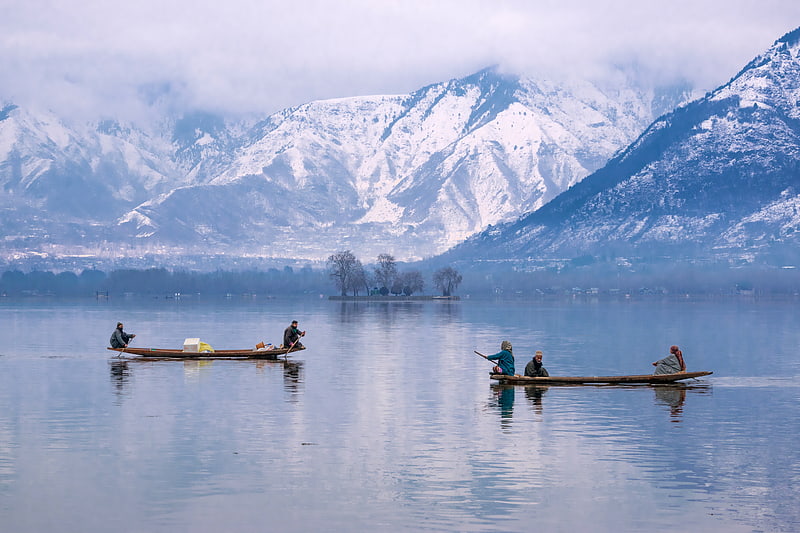
Also known as: डल झील
Lake in Asia. Dal is a lake in Srinagar, the summer capital of Jammu and Kashmir. It is an urban lake, which is the second largest in the union territory of Jammu and Kashmir. It is the most visited place in Srinagar by tourists and locals. It is integral to tourism and recreation in Kashmir and is named the "Lake of Flowers", "Jewel in the crown of Kashmir" or "Srinagar's Jewel". The lake is also an important source for commercial operations in fishing and water plant harvesting.
The shore line of the lake, about 15.5 kilometres (9.6 mi), is encompassed by a boulevard lined with Mughal era gardens, parks, houseboats and hotels. Scenic views of the lake can be witnessed from the shore line Mughal gardens, such as Shalimar Bagh and Nishat Bagh built during the reign of Mughal Emperor Jahangir and from houseboats cruising along the lake in the colourful shikaras. During the winter season, the temperature sometimes reaches −11 °C (12 °F), freezing the lake.
The lake covers an area of 18 square kilometres (6.9 sq mi) and is part of a natural wetland which covers 21.1 square kilometres (8.1 sq mi), including its floating gardens. The floating gardens, known as "Rad" in Kashmiri, blossom with lotus flowers during July and August. The wetland is divided by causeways into four basins; Gagribal, Lokut Dal, Bod Dal and Nigeen (although Nigeen is also considered as an independent lake). Lokut-dal and Bod-dal each have an island in the centre, known as Rup Lank (or Char Chinari) and Sona Lank respectively.
At present, the Dal and its Mughal gardens, Shalimar Bagh and the Nishat Bagh on its periphery are undergoing intensive restoration measures to fully address the serious eutrophication problems experienced by the lake. Massive investments of approximately US$275 million (₹ 11 billion) are being made by the Government of India to restore the lake to its original splendour.[1]
Nishat Bagh

Also known as: निशात
17th-century terraced Mughal garden. Nishat Bagh is a terraced Mughal garden built on the eastern side of the Dal Lake, close to Srinagar in the union territory of Jammu and Kashmir, India. It is the second largest Mughal garden in the Kashmir Valley. Shalimar Bagh, which is also located on the bank of the Dal Lake. ‘Nishat Bagh’ is Urdu, and means the "Garden of Joy," "Garden of Gladness" and "Garden of Delight."[2]
Sher Garhi Palace

Sher Garhi Palace is a former palace in Srinagar, Jammu and Kashmir, India. The complex is located in the south of the Old City at the banks of the Jhelum river. It was the residence of the Afghan rulers and Dogra Maharajas of Jammu and Kashmir. The name Sher Garhi means 'tiger fortress'.[3]
Hari Parbat
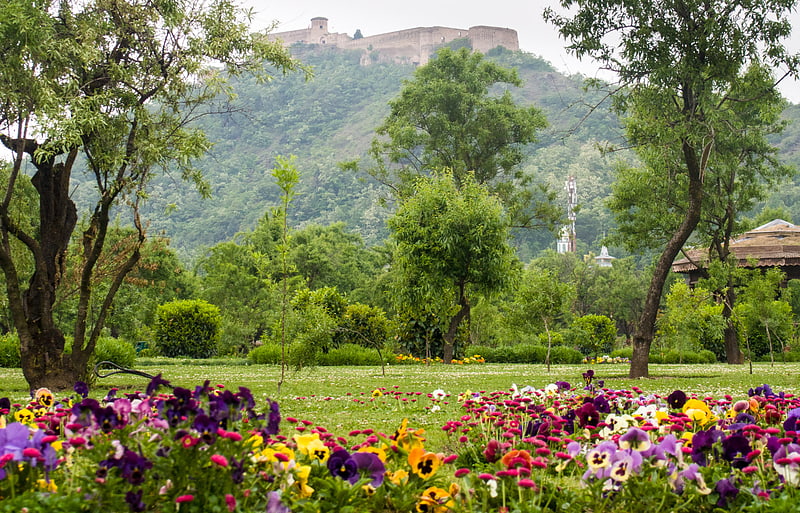
Also known as: हरि पर्वत
Tourist attraction in Srinagar. Hari Parbat, also called Koh-i-Maran, is a hill overlooking Srinagar, the largest city and the capital of the Jammu and Kashmir state, India. It is the site of a fort, built by the Durrani Empire, and of a Hindu temple, mosques, and gurdwara.
The Indian government on 15th of August 2021 (the 75th independence day) hoisted a 100 feet tall Indian flag on the top of the fort.[4]
Hazratbal Shrine
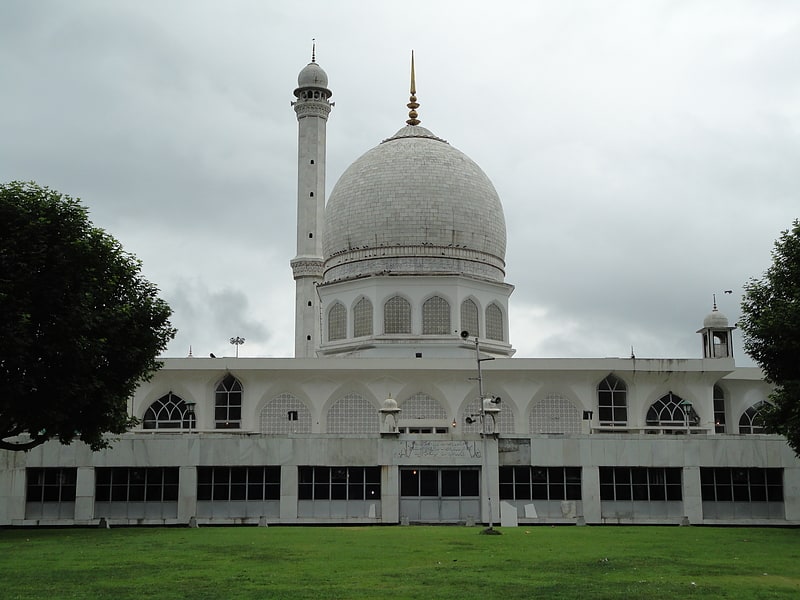
Also known as: हज़रतबल
Large shrine housing a Muslim relic. The Hazratbal Shrine, popularly called Dargah Sharif, is a Muslim shrine located in Hazratbal, Srinagar, Jammu and Kashmir, India. It contains a relic, Moi-e-Muqqadas, which is widely believed to be the hair of the Islamic prophet Muhammad. It is situated on the northern bank of the Dal Lake in Srinagar, and is considered to be Kashmir's holiest Muslim shrine.
The name of the shrine is a combination of the Persian word hazrat (lit. 'respected') and the Kashmiri word bal (lit. 'place').[5]
Address: Nagin Lake, 190007 Srinagar
Shalimar Bagh

Also known as: शालीमार बाग
Vast Mughal garden complex and public park. Shalimar Bagh is a Mughal garden in Srinagar, Jammu and Kashmir, India, linked through a channel to the northeast of Dal Lake. It also known as Shalimar Gardens, Farah Baksh, and Faiz Baksh. The other famous shoreline garden in the vicinity is Nishat Bagh, 'The Garden of Delight'. The Bagh was built by Mughal Emperor Jahangir, for his wife Nur Jahan, in 1619. The Bagh is considered the high point of Mughal horticulture. It is now a public park and also referred to as the "Crown of Srinagar".[6]
Address: Plot No-9,B-Block, Community Centre, Club Road, Shalimar Bagh, Srinagar
Jamia Masjid
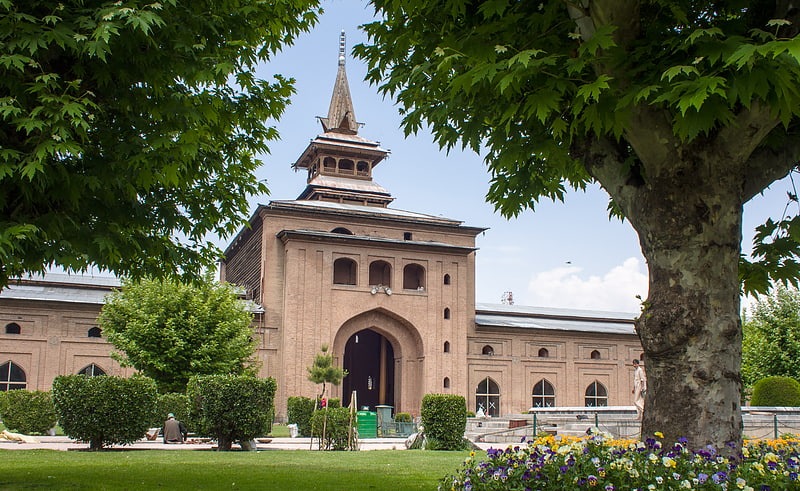
Mosque complex with gardens and fountain. Jamia Masjid is a mosque in Srinagar, Jammu and Kashmir, India. Situated at Nowhatta in the middle of the Old City, the Mosque was commissioned by Sultan Sikandar in 1394 CE and completed in 1402 CE, at the behest of Mir Mohammad Hamadani, son of Mir Sayyid Ali Hamadani, and is regarded as one of the most important mosques in Kashmir. The Mosque is located in Downtown which remains a central zone to the religio-political life in Srinagar. Thronged by Muslims every Friday, it is one of the prime tourist attractions of Srinagar.[7]
Address: Opposite, Gojwara - Islamia College Rd, 190003 Srinagar
Indira Gandhi Memorial Tulip Garden
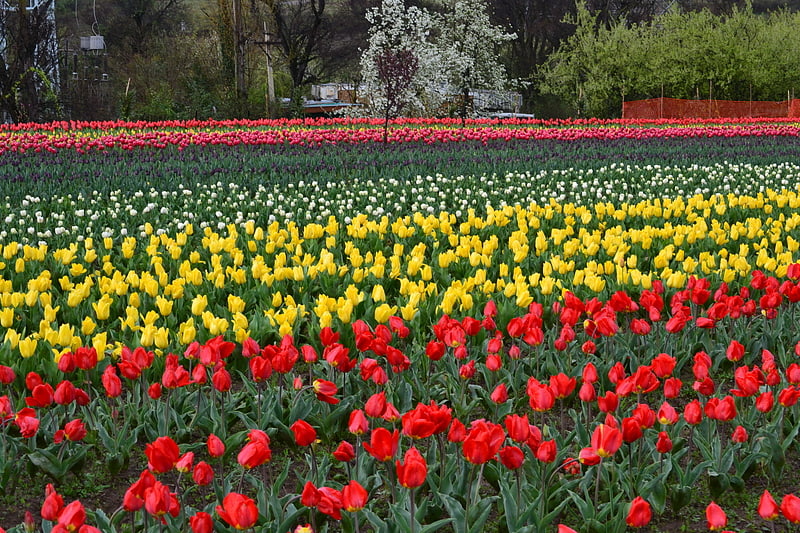
Garden in Srinagar. Indira Gandhi Memorial Tulip garden, previously Model Floriculture Center, is a tulip garden in Srinagar, Jammu and Kashmir, India. It is the largest tulip garden in Asia spread over an area of about 30 ha. It is situated on the foothills of PanchalDhar Range nowadays Pir Panjal Range with an overview of Dal Lake. The garden was opened in 2007 with the aim to boost floriculture and tourism in Kashmir Valley. It was formerly known as Siraj Bagh. About 1.5 million tulip bulbs, all in multiple colours, were brought Keukenhof tulip gardens from Amsterdam. Besides there are 46 varieties of flowers, including daffodils, hyacinth and ranunculus which were also brought from Holland. The tulip Garden is home to around 65 varieties of tulips.
The garden is built on a sloping ground in a terraced fashion consisting of seven terraces. Apart from tulips, many other species of flowers - hyacinths, daffodils and ranunculus have been added as well.[8]
Naseem Bagh
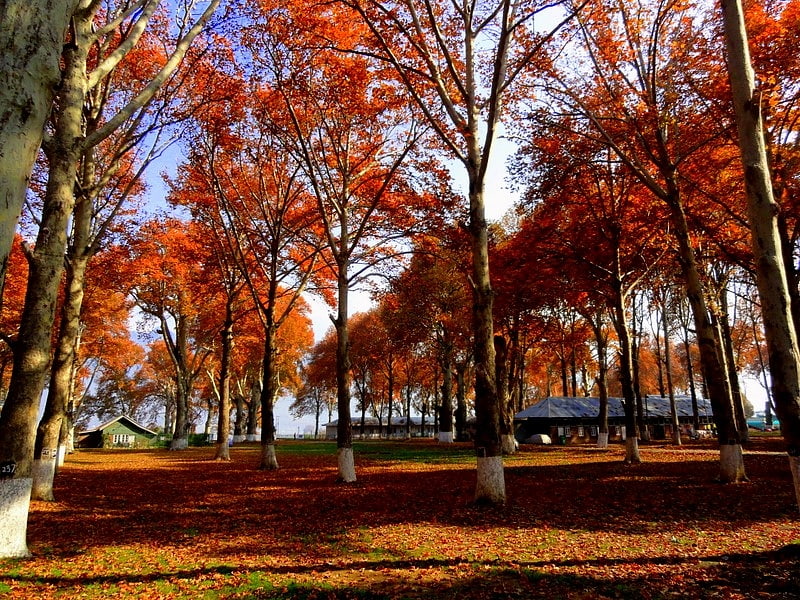
Garden in Srinagar. Naseem Bagh is a Mughal garden built on the northwestern side of the Dal Lake, close to the city of Srinagar in Jammu and Kashmir, India. The garden is one of the oldest Mughal gardens in Kashmir, built by Mughal emperor Akbar in 1586. Over 1200 chinar trees were planted in 1686 by Shah Jahan. It is developed as Chinar Heritage Park by the University of Kashmir. At present the park houses around 700 chinar trees. It is mostly visited in the autumn from September to December.[9]
Roza Bal
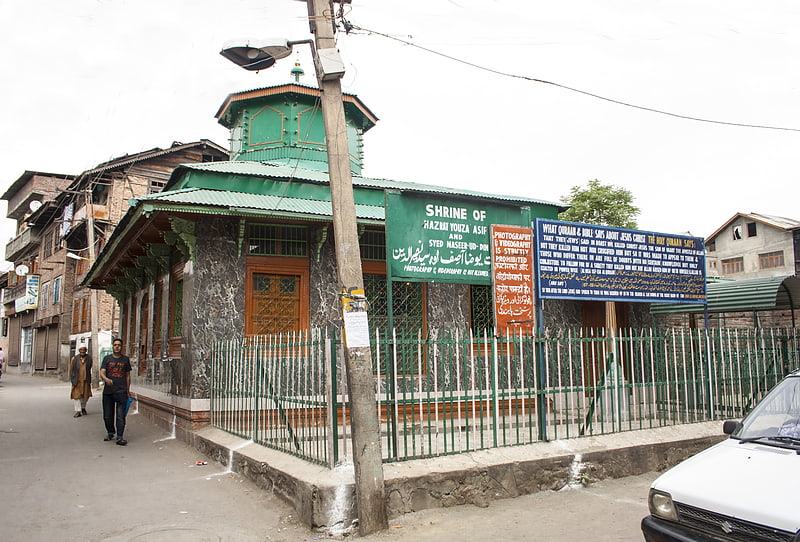
Unfussy shrine with a storied history. The Roza Bal, Rouza Bal, or Rozabal is a shrine located in the Khanyar quarter in downtown area of Srinagar in Kashmir, India. The word roza means tomb, the word bal mean place. Locals believe a sage is buried here, Yuz Asaf, alongside another Muslim holy man, Mir Sayyid Naseeruddin.
The shrine was relatively unknown until the founder of the Ahmadiyya movement, Mirza Ghulam Ahmad, claimed in 1899 that it is actually the tomb of Jesus. This view is maintained by Ahmadis today, though it is rejected by the local Sunni caretakers of the shrine, one of whom said "the theory that Jesus is buried anywhere on the face of the earth is blasphemous to Islam."[10]
Shankaracharya Temple

Also known as: शंकराचार्य मंदिर
Hindu temple in Srinagar. Shankaracharya Temple or Jyeshteshwara Temple is a Hindu temple situated on top of the Shankaracharya Hill on the Zabarwan Range in Srinagar, Jammu and Kashmir, India. It is dedicated to Lord Shiva. The temple is at a height of 1,000 feet above the valley floor and overlooks the city of Srinagar.
On festivals such as Herath, as Maha Shivratri is known as in the region, the temple is visited by Kashmiri Hindus. The temple is also considered as a Buddhist icon, and with the hill which has had multiple names over the centuries, is connected to the Persian and Muslim faith as well.
The temple and adjacent land is a monument of national importance, centrally protected under the Archaeological Survey of India. Dharmarth Trust has managed the temple since the 19th century, along with others in the region. Karan Singh is the sole chairperson trustee.[11]
Khanqah-e-Moula

Khanqah in Srinagar. Khanqah-e-Moula, also known as Shah-e-Hamadan Masjid and Khanqah, is the first mosque in the Jammu and Kashmir, located in the Old City of Srinagar, Jammu and Kashmir, India. Situated on the right bank of the river Jhelum between the Fateh Kadal and Zaina Kadal bridges, it was first built in 1395 CE, commissioned by Sultan Sikendar. It is one of the best examples of Kashmiri wooden architecture, and is decorated with papier mache.[12]
Habba Kadal
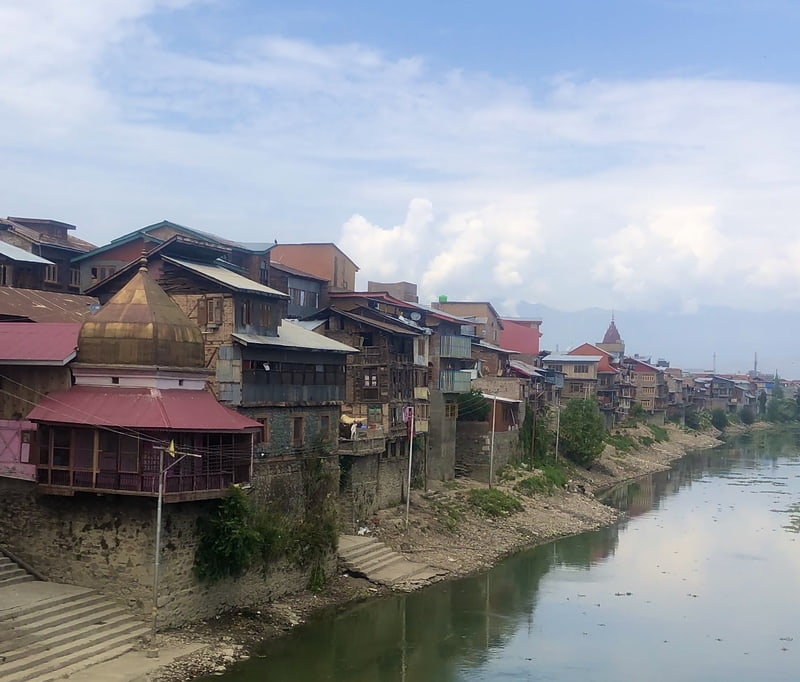
Habba Kadal is a wooden bridge located in the old city of Srinagar, in Jammu and Kashmir, India that crosses the Jhelum river. It was first built in 1551 by Sultan Habib Shah of the Shah Miri Dynasty and is one of the seven original bridges that have existed in the city for a long time. It had to be rebuilt during Dogra rule after the heavy floods of 1893. Although originally planned to be dismantled as the New Habba Kadal bridge made it redundant, the government, as part of its policy of preserving heritage, undertook renovation of the bridge. It was started in 2013 and took two years to complete. Finally, the bridge again opened to public in 2015.[13]
Shankaracharya Hill

Shankaracharya Temple or Jyeshteshwara Temple is a Hindu temple situated on top of the Shankaracharya Hill on the Zabarwan Range in Srinagar, Jammu and Kashmir, India. It is dedicated to Lord Shiva. The temple is at a height of 1,000 feet above the valley floor and overlooks the city of Srinagar.
On festivals such as Herath, as Maha Shivratri is known as in the region, the temple is visited by Kashmiri Hindus. The temple is also considered as a Buddhist icon, and with the hill which has had multiple names over the centuries, is connected to the Persian and Muslim faith as well.
The temple and adjacent land is a monument of national importance, centrally protected under the Archaeological Survey of India. Dharmarth Trust has managed the temple since the 19th century, along with others in the region. Karan Singh is the sole chairperson trustee.[14]
Chashme Shahi
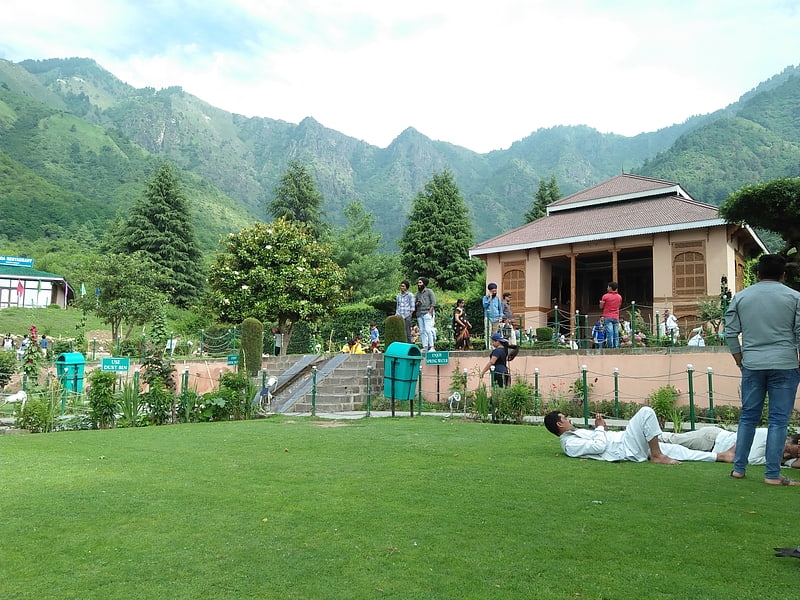
Also known as: चश्माशाही
Garden in Srinagar. Chashme Shahi or Chashma i Shahi Or Cheshma Shahi, also called Chashma Shahi or Cheshma Shahi, is one of the Mughal gardens built in 1632 AD around a spring by Ali Mardan Khan, a governor of Mughal emperor Shah Jahan as per the orders of the Emperor, as a gift for his eldest son Prince Dara Shikoh. The garden is located in the Zabarwan Range, near Raj Bhawan overlooking Dal Lake in Srinagar, Kashmir, India.[15]
Address: Nr. Rajbhawan, 190001 Srinagar